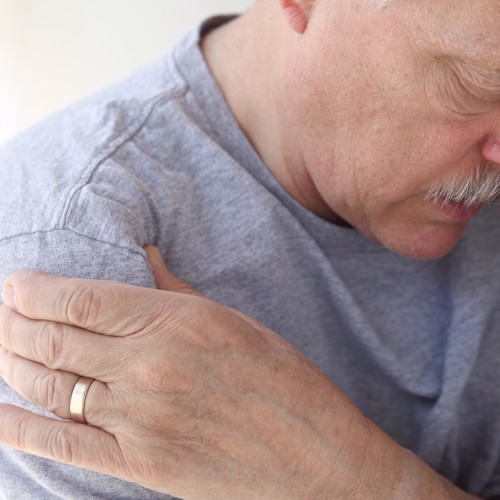Rotator Cuff Related Shoulder Pain - New name, new evidence?
NO
PHARMACEUTICAL INFLUENCE
Rotator Cuff Related Shoulder Pain - New name, new evidence?

Bob has just turned 47, and by his own admission is an impatient man. He is getting some pain again in his shoulder which is affecting his weekend games of tennis, so has booked to see you so he can get a steroid injection ‘to keep my shoulder ticking over’. He’s actually still managing to play tennis but is struggling more with serving. A quick review of his notes show he has had a few injections over the past 5-6 years. His assessment confirms he has got subacromial shoulder pain, but is a steroid injection really the right thing for him? And what evidence is there to help guide management of this very common problem?
First the terminology, which seems to be unnecessarily complicated. It has been called many things over the years - subacromial bursitis, shoulder tendinitis, supraspinatus tendinopathy, impingement etc. It is now thought the problem is due to tendinopathy and degeneration of the rotator cuff/tendons, but is probably a combination of lots of different pathologies with a broadly unifying presentation and management. The preferred terms currently seem to be subacromial shoulder pain or rotator cuff related shoulder pain (RCRSP).
RCRSP is the most common shoulder problem we see, accounting for 70% of all shoulder presentations, yet for such a common condition the evidence base on how to best manage it is limited. Many of us will have used corticosteroid injections (CSI) as a mainstay of treatment for years, but as discussed in the Lancet 2021, CSI probably only gives short term benefit at best, and what evidence we have is based on small trials with no data beyond 6 months. So what about physiotherapy? Again the evidence is limited. The latest Cochrane review 2016 cited a lack of any convincing evidence for manual therapies, with the more recent Lancet paper confirming most studies to be small, short term (<6 months) with considerable heterogeneity.
So a well conducted RCT (GRASP trial Lancet 2021) recently reported in the BMJ 2022;378:o1776 is welcome. This is the largest RCT to date on rotator cuff shoulder disorders and was a multi-centre trial based in the UK and funded by the NIHR, which randomised >700 patients to one of 4 arms - one off physio appointment with self-guided exercises at home (with support materials - booklet and videos) or up to 6 progressive face-to-face physio sessions, each with or without CSI (using a standard injection dose ≤40mg triamcinolone or methylprednisolone) with participants reviewed at 8 weeks, 6 months and 12 months.
The results showed no difference in pain and disability scores between the one off physio/home exercise group and progressive physio group at any any point. As far as CSI goes there were small benefits in favour of CSI at 8 weeks, but this had disappeared by 6 months with still no difference at 12 months. Although only based on subgroup analysis those with more severe symptoms seemed to benefit more from CSI than those with less severe symptoms.
This study has important implications for us in primary care, both on an individual and service provision level. Many PCNs will now have physios or MSK practitioners in their teams and this study would support using them for an initial point of contact session for rotator cuff shoulder disorders followed by guided self help exercises at home. Indeed the conclusion of the GRASP trial was that ‘a single face-to-face session with a physiotherapist is likely to be more cost-effective and is not significantly different in terms of clinical outcomes when compared with a comprehensive physiotherapy intervention of up to six face-to-face sessions’. If you don’t have direct initial access to physiotherapy, it would also seem reasonable to make an initial diagnosis in primary care and direct patients to information about the condition and progressive home exercises for 6-12 weeks, which can be accessed for free on the excellent BESS (British Elbow and Shoulder Society) website here.
As for CSI this study confirms the ‘direction of travel’ that CSI can be considered an adjunct to exercise therapy rather than a treatment in its own right, and that it may be most beneficial for those with more severe symptoms (e.g. if unable to effectively do the exercise regime). The other important point on CSI highlighted in the BESS primary care shoulder guideline is that no more than 2 injections are recommended as there is emerging evidence that multiple injections may cause tendon damage.
So what are we going to do with Bob? Well, a one off physio session and home exercises are likely to be his best bet, and if he really wants to continue to play tennis into his dotage repeated steroid injections may not be a great idea due to the risk of tendon damage. Bob certainly doesn’t want to risk any long term tendon damage, so is quite happy to try exercise therapy at home for a couple of months and promises he will be a bit more patient!
Dr Rob Walker
13th October 2022
Join us at one of our upcoming courses or live webinars

Recent NB Blogs
Need an immediate update? – all our courses are available on demand
Did you find this useful?
You can quickly add CPD to your account by writing a reflective note about the Rotator Cuff Related Shoulder Pain - New name, new evidence? post you've read.
Log in to your NB Dashboard and use the 'Add Reflective Note' button at the bottom of a blog entry to add your note.

